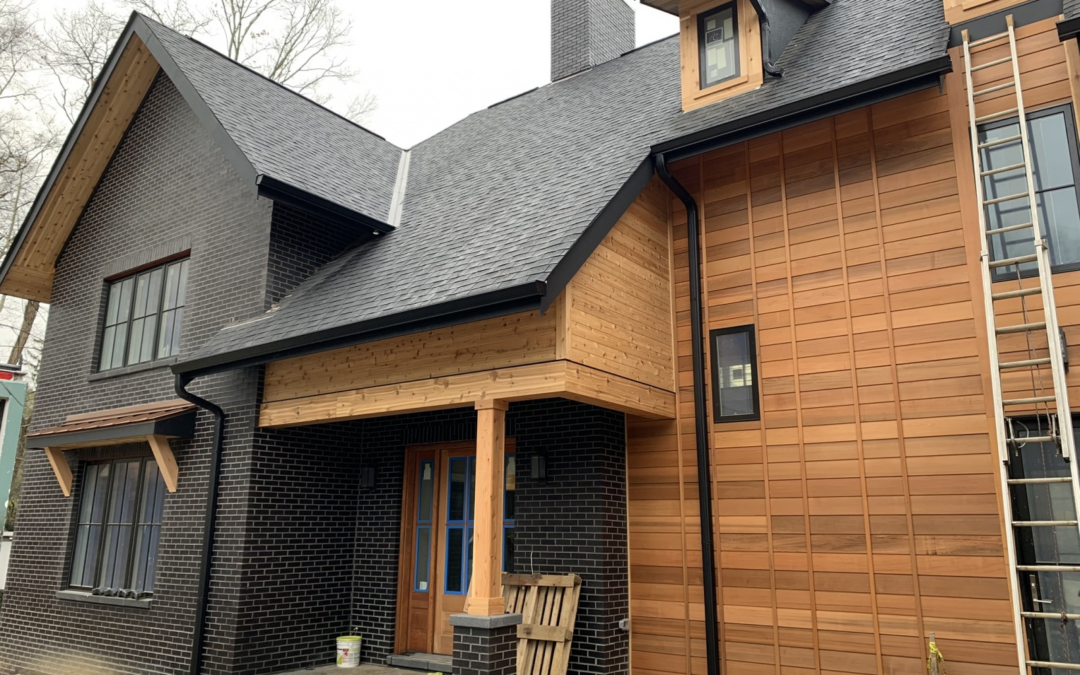The wood soffit is an often-overlooked yet crucial part of your home’s exterior. It not only adds a clean, finished look to your roofline but also plays a key role in protecting your home from moisture and ensuring proper ventilation. Over time, however, wood soffits can experience wear and tear, leading to the need for repairs or full replacement. In this guide, Big Orange Gutters, serving Nashville and Knoxville, TN, will explore the ins and outs of wood soffit repair and replacement.
Understanding the Wood Soffit
The soffit is the horizontal surface beneath the roof overhang, connecting the edge of the roof to the side of your home. In homes with wood soffits, this element contributes to both aesthetics and functionality. It helps ventilate your attic, keeping your home cooler and preventing moisture buildup that could lead to mold or structural damage. Without a properly functioning soffit, your home could face serious issues like roof rot, insulation damage, and increased energy costs.
Signs Your Wood Soffit Needs Repair or Replacement
Over time, wood soffits are exposed to harsh weather conditions, and Nashville and Knoxville’s seasonal rains and humidity can take a toll. Here are common signs that your wood soffit may need attention:
- Peeling or Cracked Paint: This is one of the earliest signs of soffit damage. When the paint on a wood soffit begins to peel or crack, it can expose the wood to moisture, leading to further damage.
- Rotting Wood: Soft, spongy, or crumbling wood is a sign that rot has set in. Wood soffits, if not properly maintained, can absorb moisture, leading to structural damage and even pest infestations.
- Water Stains: If you notice stains or discoloration on your soffit, it’s often an indicator that water has penetrated the wood, which can lead to rot if not addressed promptly.
- Pest Infestations: Gaps or holes in your wood soffit can invite pests like birds, rodents, or insects to enter your attic. This can result in further damage and potential health risks for your household.
- Ventilation Issues: If your attic is too warm or humid, it could mean that your soffit is blocked or damaged, preventing proper air circulation. This can increase energy costs and lead to moisture-related problems in your attic and roof.
Common Causes of Wood Soffit Damage
Wood soffits are vulnerable to a variety of issues, especially in regions with fluctuating weather patterns like Nashville and Knoxville. Understanding the causes of wood soffit damage can help you prevent further deterioration:
- Moisture and Water Exposure: Rain, humidity, and condensation can cause wood to absorb moisture. Over time, this leads to wood rot, mold growth, and structural weakening.
- Sun Damage: The hot Tennessee sun can dry out wood soffits, causing them to crack or become brittle. UV rays also fade and weaken paint, leaving the wood vulnerable to moisture intrusion.
- Pests: Termites, carpenter ants, and other pests can invade and cause significant damage to wood soffits, eating away at the structure and compromising its integrity.
- Improper Installation: If the soffit wasn’t installed correctly, it may lack proper ventilation or weatherproofing, making it more susceptible to damage over time.
The Wood Soffit Repair Process
If your wood soffit is damaged, repairs can restore its appearance and functionality. Here’s an overview of the typical repair process:
- Assessment and Inspection: The first step is a thorough inspection to identify areas of rot, water damage, or pest activity. This helps determine the extent of the damage and whether repair or replacement is needed.
- Removing Damaged Wood: If only certain sections are affected, the damaged wood is carefully removed. This may involve cutting away small areas or removing entire soffit boards, depending on the level of damage.
- Replacing the Soffit: New wood pieces are cut to fit the removed sections. It’s important to match the type and size of the wood with the existing soffit for a seamless repair. Before installation, the new wood is typically primed and sealed to protect it from future moisture exposure.
- Sealing and Painting: After the replacement wood is installed, the next step is to seal and paint the entire soffit. This not only protects the wood from future damage but also ensures a uniform look across your home’s exterior.
- Ensuring Proper Ventilation: A crucial part of the process is checking that the soffit vents are clear and functioning. Adequate ventilation is essential to prevent moisture buildup in the attic and to extend the life of your roofing system.
Benefits of Replacing a Wood Soffit
In cases where the damage is too extensive for repairs, full soffit replacement may be necessary. Here are some of the advantages of replacing your wood soffit:
- Increased Durability: A new wood soffit provides better protection against water, pests, and the elements. It can significantly improve the lifespan of your roof and home exterior.
- Improved Aesthetic Appeal: Replacing an old or damaged wood soffit can refresh the look of your home, boosting its curb appeal and value.
- Enhanced Ventilation: A properly installed wood soffit ensures better attic ventilation, which can improve energy efficiency and prevent costly moisture damage.
- Better Pest Protection: A new, tightly sealed soffit will keep pests out, reducing the risk of infestations in your attic or roof.
Wood Soffit vs. Alternative Materials
If you’re considering replacing your wood soffit, there are other materials available that might suit your needs depending on your long-term goals for maintenance and durability:
- Vinyl Soffit: Vinyl is a popular choice for its durability and low maintenance. It doesn’t rot, peel, or attract pests like wood can. Vinyl soffits also come in a variety of colors and styles, offering versatility in design.
- Aluminum Soffit: Aluminum is another low-maintenance option that resists rust and corrosion. It’s particularly suited for homes in areas with high humidity, making it a practical choice for Tennessee’s climate.
- Composite Soffit: Composite soffits are made from a blend of wood fibers and resins, offering the appearance of wood with increased resistance to moisture and pests. This option is durable and requires less maintenance than traditional wood.
Maintenance Tips for Your Wood Soffit
Whether you’ve just had a wood soffit repaired or replaced, maintaining it properly is key to ensuring it lasts. Here are a few tips to keep your wood soffit in good condition:
- Regular Inspections: Check your soffit at least once a year for signs of damage, such as peeling paint or moisture spots. Early detection can prevent larger issues down the road.
- Keep Gutters Clean: Clogged gutters can lead to water overflow, which can damage the soffit. Regular gutter cleaning ensures that water is directed away from your home’s structure.
- Repaint When Necessary: Repainting your wood soffit every few years can protect it from the elements and keep it looking fresh.
- Monitor Ventilation: Make sure your attic and soffit vents are clear of debris to maintain proper airflow and prevent moisture buildup.
Conclusion
Wood soffit repair and replacement are essential for maintaining the beauty and function of your home’s exterior. Whether it’s repairing a small section or replacing an entire soffit, addressing issues as soon as they arise can help prevent more serious problems like water damage, pest infestations, and ventilation issues.
At Big Orange Gutters in Nashville and Knoxville, TN, we understand the importance of protecting your home from the elements. This guide aims to provide you with the information needed to make informed decisions about your wood soffit repair and replacement needs. For more tips on maintaining your home’s exterior, stay tuned to our blog for valuable insights!

